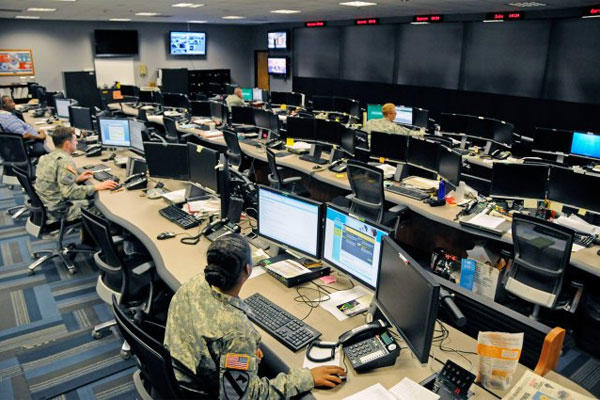WASHINGTON -- The Army cyber mission force, or CMF, has grown "exponentially since September 2013 with 25 of 41 [planned] teams at initial operating capability," Lt. Gen. Edward C. Cardon told lawmakers, March 4.
"We are on track to have all 41 CMF teams established and operating by the end of fiscal year 2016. However, they will not all be fully operationally capable until FY17," he said. CMF teams are allocated to combatant commanders, where they provide defensive and offensive cyber capabilities.
Cardon, who is the commander of U.S. Army Cyber Command, or ARCYBER, and Second Army, addressed "operationalizing cyberspace" in oral and written testimony. He and his counterparts from the other services appeared before the House Armed Services Subcommittee on Emerging Threats and Capabilities.
GUARD, RESERVE CAPABILITIES
Besides the CMF teams, Cardon said ARCYBER will create "a total, multi-component Army cyber force that includes 21 Reserve-component cyber protection teams, trained to the same standards as the active-component cyber force."
In October 2014, one Army National Guard cyber protection team was activated and is in Title 10 status, he added, meaning those Guard Soldiers are now on active duty.
It is sometimes a bit tricky to get the proper authorities to activate Reserve-component Soldiers, he said.
Authorities are a "complex problem" and "remain a challenge," Cardon said. "While Title 10 authorities are clear, Title 32 and state active duty require the application of varied state constitutional, legislative, and executive authorities and coordination with state agencies and officials."
There is merit in developing a common approach in every state for authorities and capabilities to facilitate a more rapid and effective response in cyberspace operations, he added.
Reserve-component cyber experts are a tremendous resource, he said, pointing out that both Guard and Reserve Soldiers already have the acquired cyber skills that will enable them to integrate more quickly into the cyberspace force than if they had to be trained from scratch.
Guard and Reserve Soldiers routinely augment the active cyberspace force and are supporting missions both here in the United States, as well as overseas, including Afghanistan and other areas in Southwest Asia, he added.
GROWING CYBER FORCE
To keep the cyber force on an "exponential" growth track, Cardon described a number of measures the Army is taking to retain and recruit the best.
The Army has enjoyed success with in-service recruiting from other military occupational specialties and is actively working to assess high-quality recruits through innovative marketing techniques, he said.
The Cyber Center of Excellence on Fort Gordon, Georgia, is developing an initiative to encourage cadets at both the U.S. Military Academy at West Point, New York, or USMA, and ROTC to apply themselves in science, technology, engineering and mathematics. "We will commission the first 30 Cyber Branch officers from both USMA and ROTC programs this summer," Cardon said.
The Army is now working to implement a Cyber Career Management Field for enlisted personnel by the end of this fiscal year, he said. That field will encompass accessions, career management, and retention.
Also, the Army recently approved special-duty assignment pay, assignment incentive pay, and bonuses for Soldiers serving in operational cyber assignments.
For Soldiers transferring from the active force to one of the Reserve components, Cardon said the Army has sweetened the deal with some of those bonuses.
Besides special pay and bonuses, he said training opportunities abound.
"We have also expanded cyber educational programs, including training with industry, fellowships, civilian graduate education and utilization of inter-service education programs" like the Air Force Institute of Technology and the Naval Postgraduate School, he added. "We are confident these will serve as additional incentives to retain the best personnel for this highly technical field."
The picture isn't as rosy for civilian cyber hires, however, he reminded lawmakers.
Recruiting and retaining Army civilian cyber talent "is challenging given internal federal employment constraints regarding compensation and a comparatively slow hiring process. Current efforts to attract and retain top civilian talent include extensive marketing efforts, and leveraging existing programs and initiatives run by the National Security Agency, Office of Personnel Management, and National Science Foundation."
DANGEROUS WORLD
Cyberspace continues to grow more complex, with sophisticated threats that are capable of exploiting known and unknown vulnerabilities, threatening both national security and America's economic interests, he warned.
Cardon pointed to the recent attacks on Sony Pictures Entertainment and Anthem health insurance, as well as the Heartbleed bug that left systems around the world vulnerable to attack, as being just the tip of the iceberg.
"Electronic devices are increasingly embedded in everything from vehicles to guided missiles, and are often integrated into systems which are difficult and costly to update or upgrade as new threats or vulnerabilities are identified with increasing speed and widely ranging tempo," he explained. "These factors represent malefactors impacting our warfighting systems."
To counter these threats, Cardon said the Army and its sister services are pursing the Joint Regional Security Stack initiative, a component of the Joint Information Environment, or JIE, which will "consolidate and improve the security of currently disparate networks.
"We have to modernize and get to the JIE as quickly as possible for improved mission effectiveness, enhanced security, and to increase efficiency," he continued.
Other initiatives, he said, include network mapping, cloud and virtualization, and cyber infrastructure, and platforms and tools. Also, the Army is partnering with the Defense Advanced Research Projects Agency, or DARPA, on its Plan X Cyberwarfare Program that is developing platforms for the execution of cyber operations.
Finally, Cardon noted that continued funding of these and other initiatives is important for national security. He said the Army is grateful that the president's FY16 budget included $90 million to build a state-of-the-art cyber headquarters and operations facility on Fort Gordon, Georgia.



























